#gallo roman paganism
Text
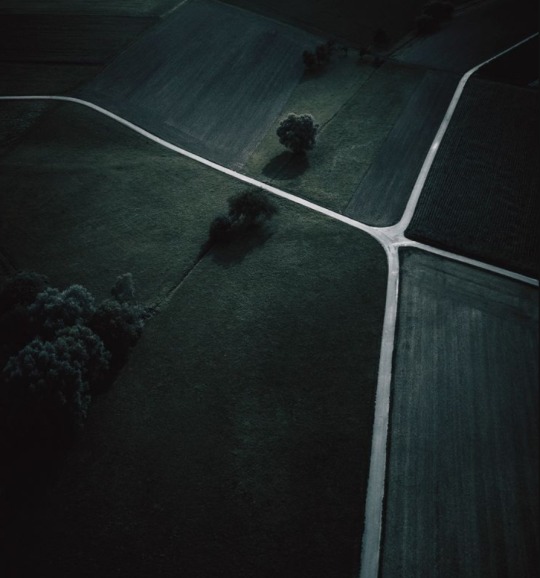

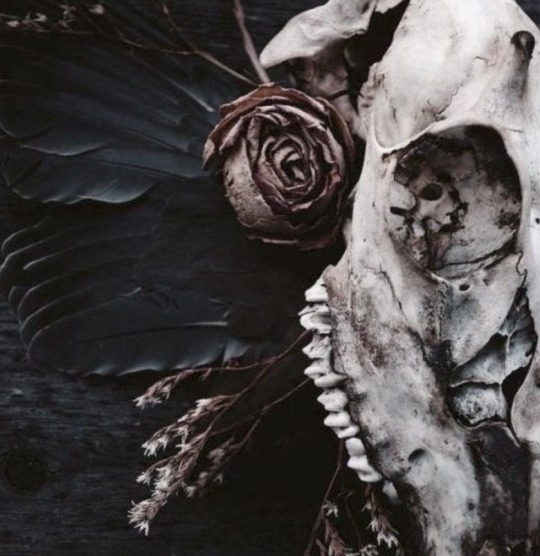
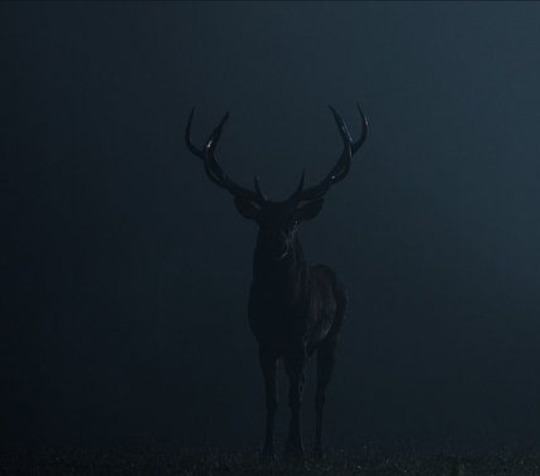

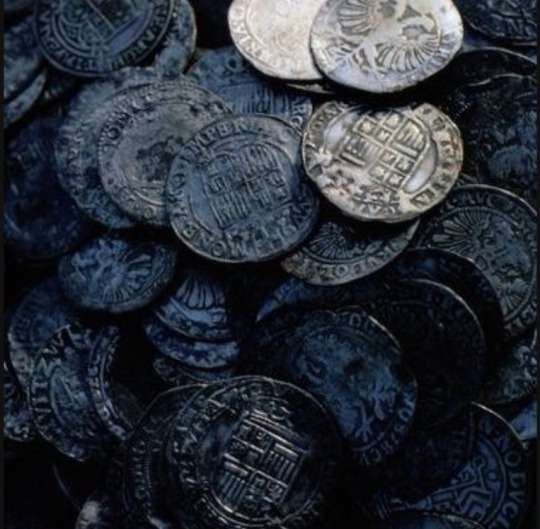
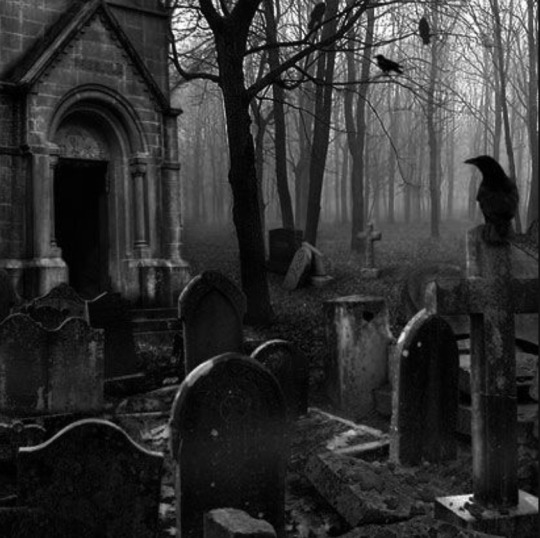

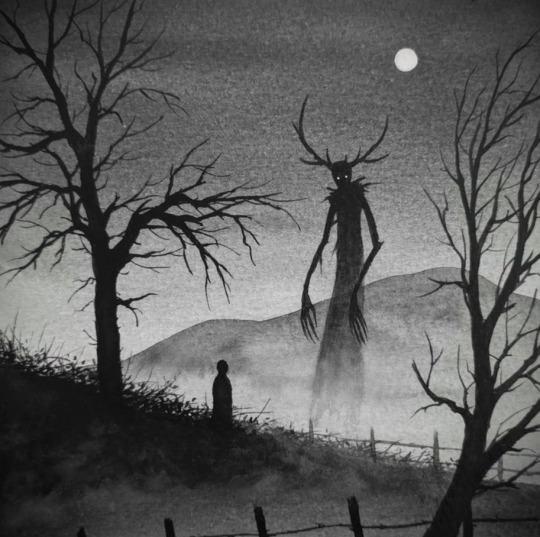
Cernunnos
Gaulish God of liminality, crossroads, death, pastoral wealth, abundance, hunters, the hunted, the wild, and the tame.
#Cernunnos#Carnonos#Karnonos#gaulish gods#gaulish paganism#gualish polytheism#gallo roman paganism#gallic gods#celtic paganism#celtic pagan#celtic pantheon#pagan#deities#polytheism#polytheist#deity#paganism#devotional moodboard#deity moodboard#the horned god#the horned one#wicca#wiccan#paganblr#chthonic#chthonic gods#godspouse#moodboard
31 notes
·
View notes
Text

Celtic-Roman syncretic Altar. Specifically leaning more into Gallo-Roman specifically with wiccan influence. Druantia stands center on my altar as she's both god and goddess as one.
83 notes
·
View notes
Text

Credits to the wonderful people of NorthMyth on Etsy for their impeccable craftsmanship and speedy delivery. Support them, if you can. Ukrainian artists deserve our aid!
#statues#statuettes#woodcarving#woodcarvers#gods#pagan#pagan gods#gaulish pagan#roman gods#Gaulish#Roman#roman paganism#gaulish polytheism#roman polytheism#gallo roman#Gaul#Moccus#cernunnos#Epona#Sulis#Taranis#Janus#Ukrainian#ukrainian art#ukrainian artists#polytheism#paganism#Celtic#Celt paganism#celtic polytheism
140 notes
·
View notes
Note
Know any good sources on Celtic (specifically Gaulish practices)? I know it’s not your area, but you seem like someone who might know some people who dabble in that sort of stuff. The area I live in has some celtic archeological sites, but sadly not much is known about the local religion or culture. I am trying to put together a Romano-Celtic hearth cult, but it’s difficult finding practices and deities that feel right.
Gaul is a larger Celtic area of Western Europe (modern-day France and parts of modern-day Belgium, Germany, and Northern Italy). I say this because the Celts, when invaded by Rome, took in a lot of Roman religion including Hellenic and (rarely) Kemetic beliefs as well. When the Celts did this, so did the Gauls.
If it helps at all, the specifics you're looking into is called Gallo-Roman, which is part of the larger Romano-Celtic area.
This selective acculturation manifested in several ways. One of the main ways we see this is with the melding of Greco-Roman deities with Gaulish (Celtic) deities. Gaulish epithets for Roman gods (Jupiter Poeninus) and Roman epithets for Gaulish gods (Lenus Mars). Roman gods were given Gaulish god partners (Mercury and Rosmerta & Apollo and Sirona). Towards the east of the Gauls, many mysteries were formed, including one for the Greek hero Orpheus, the Iranian (or Persian) god Mithras, and the Egyptian goddess Isis. In other words, a whole lot of syncretism.
When it came to the Gauls (and the Celts overall) a main part of their belief system was the heavy use of animal imagery. More specifically, zoomorphic deities. However, we see a lot more human-looking representations of the gods because the Romans (and Greeks) weren't too keen on the idea (see Greco-Egyptian).
As for specifically Gallo-Roman hearth religious beliefs, the Lares (Lar singular) is a good place to start. They're the equivalent of Agathos Daimon in Greek religion (Hellenism). Essentially, they're personal household deities that are connected to the hearth.
A majority of the information we have about the Gaelic culture and the eventual melding of the Gallo-Roman culture stems from two sources: artifacts and Julius Ceasar, who wrote all about in what we now call the "Commentarii de Bello Gallico". The gods that he mentions the Gauls worship (like Jupiter, Mercury, Mars, and Minerva) aren't really the Roman gods that the Gauls are worshipping at that time but rather the closest thing Ceasar can connect. For example, Caesar may say that the Gauls worshipped Mars, when in reality they were worshipping Lenus, a healing god that quickly became associated with Mars because of Caesar and the Roman Empire. However, not all of them were caught. Gobannus is the most well-known example we have, with him being the equivalent to the Roman god Vulcan or the Greek god Hephaestus and yet Caesar makes no comment on the Gaulish god.
One other thing, the specific time we are taking a look at was prior to the overtaking by the Anglos, Saxons, and Jutes (aka pre-Anglo-Saxon times). Because of this, Germanic (Norse) gods weren't known to these people yet. Odin, Thor, and Freyja were unknown to them at this point in time.
Other than that, the last thing I can give to you are articles and books that I stumbled upon that may pique your interest. I do recommend a couple of Wikipedia links, but just know that I recommend using Wikipedia as a jumping-off point. Hope this helps! :^)
Becoming Roman: the origins of provincial civilization in Gaul -- Greg Woolf
https://archive.org/details/becomingromanori0000wool
The gods of the Celts -- Miranda Green
https://archive.org/details/godsofceltsar00mira
Gallo-Roman Religious Sculptures -- A.N. Newell
https://www.jstor.org/stable/640758
Fifth-Century Gaul: A Crisis of Identity? -- John Drinkwater & Elton Hugh
https://www.loc.gov/catdir/samples/cam031/91018375.pdf
Caesar's Commentaries on the Gallic War: literally translated -- Frederick Holland Dewey, A.B.
https://archive.org/details/caesarscommentar07caes
Category:Gaulish gods -- Wikipedia
https://en.wikipedia.org/wiki/Category:Gaulish_gods
Category:Gaulish goddesses -- Wikipedia
https://en.wikipedia.org/wiki/Category:Gaulish_goddesses
sources:
https://bmcr.brynmawr.edu/1999/1999.10.34/
http://www.deomercurio.be/en/dii.html
https://www.britannica.com/topic/Celtic-religion/The-Celtic-gods
https://en.wikipedia.org/wiki/Lares
https://www.britannica.com/topic/Lar-Roman-deities
https://en.wikipedia.org/wiki/Gallo-Roman_culture
https://en.wikipedia.org/wiki/Gallo-Roman_religion
#ask#witch#witchcraft#witchblr#pagan#celtic#gaulish#roman#celtic deities#celtic pantheon#gaulish deities#gaulish pantheon#roman pantheon#roman gods#ancient rome#gallo-roman#romano-britain#romano-celtic#hearth
37 notes
·
View notes
Text
A prayer to Diana

Decided to share a prayer card+prayer I wrote for Diana🏹 Keep in mind this is centered around her as Diana-Abnoba, the syncretism between the two, and Abnoba as an epithet of Diana. Feel free to use this prayer or change it up to fit you better! Or edit it to focus solely on Diana or a different epithet!
Lady Diana Abnoba,
May your name be carried through the wind in the trees, the rushing rivers and streams
Queen of the groves and mysteries of the forest
May your moonlight illuminate the path through the long distance of trees
Huntress, lady of the mountains, spirit of the wilderness
May the arrows of your bow be my guide through the deepest and darkest of the wood
🌙🌿
#prayers#diana🌙#diana abnoba#abnoba#prayer card#I also made the prayer beads!!#my posts#pagan#gallo roman
20 notes
·
View notes
Text

Diana and Roman-Celtic Syncretism
═══════ ◖◍◗ ═══════
introduction
[images in this post have been added for aesthetic purpose only and do not contain relevant text. any relevant images will be described using image ID]
As a witch, I make it my aim to know the Gods as well as I possibly can, to explore their many epithets, counterparts and aspects. When I first started, I initially followed the Hellenic Pantheon, this then expanded into their Roman counterparts, and by extension of this, I explored not only the original Celtic Polytheism (in particular the Tuatha De Dannann, the Irish Gods, but the Gaulish epithets of the Roman Gods.
Very recently, I came back into contact with Diana-Artemisa. I had honoured her previously, but I was interested in reconnecting to the earth and to the forest, and she was there for me. This initiated my research into today's topic, Roman-Celtic syncretism of the Goddess Diana.
A few notes before we get started. Today I am focusing on the Gaulish-Celtic regions, so I will refer to the Gauls, Gaulish worship and language accordingly. I am also referring to Diana-Artemisa as 'Diana' as today we are specifically looking at Roman-Gaulish Syncretism, so she is being referred to as her Roman face.
Hope you enjoy the post!
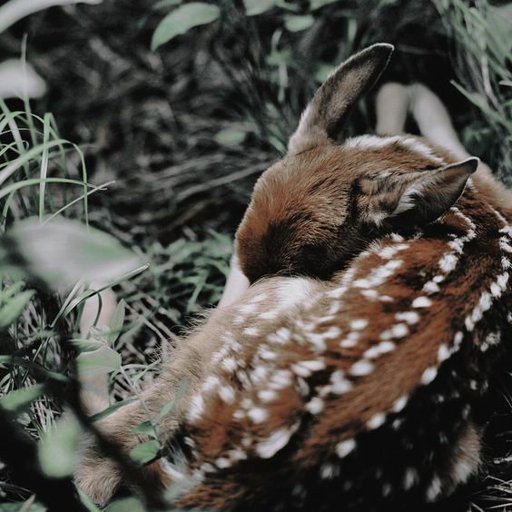
═══════ ◖◍◗ ═══════
religious syncretism
Religious Syncretism is a topic that has been discussed in this community before, and has been done so in a more sophisticated manner, and I thoroughly recommend further research on the topic outside of my post.
To put it simply, religious syncretism is when multiple religions or aspects of a religion are in contact and begin to mix or combine. This often happens between regions that are close to one another geographically, through trade routes, regular communication through regions, but it can also take place as a result of war, imperialism or colonisation, which is important historical nuance to consider when approaching this subject.
In terms of Roman religion, that which we are discussing today, Roman society had a tendency towards Syncretism. The connection between Greek and Roman religion for example is often discussed, the Romans identifying their own Gods, sometimes seen as counterparts of the Hellenic Gods, by similar powers.
Religious Syncretism also happened between Roman and Gaulish religions, Gallo-Roman religion was a result of occupation from the ruling Roman empire. While the Roman's did not necessarily impose their religion and gods (though they did impose themselves in other ways such as taking over the land through imperialist means), Roman-Gaulish religion is characterised by how the Gauls adopted Roman language, culture and beliefs.
With that established...

═══════ ◖◍◗ ═══════
Gaulish Worship of Diana
Diana is primarily known as a Virgin Goddess, a Goddess of the Hunt, protector of women, Goddess of both the Moon and the Forest, and in Gaulish worship it is clear that she was seen as relatively important and that her worshippers were faithful to her. Diana became associated, or seen as one and the same as a few pre-existing goddesses, which i will discuss further in detail in a few moments.
In Gaul, Diana was frequently attributed the Epithet "Augusta", 'regina', meaning Queen. She was often also referred to as being holy, which was not used as a descriptor for all deities at the time. Across Gaul, there were something of 85 inscriptions written in the name of Diana, while 13 also appeared in Great Briton, Diana's worship while often seen specifically in Gaul also extended to other Celtic regions such as Briton.
While it cannot be argued that Diana is the most significant deity within Gaul, her worship and importance cannot be denied, the label of her as a queen indicates very clearly that Diana was revered. The Gauls worshiped Diana much as they worshiped other deities, honouring the Goddess within the Cult regulations of the Temple of Aventine (the temple being significant in Diana's association as a protector of Refugees). They also notably celebrated her on the day of Nemoralia.
Part of the Gaul's association with Diana comes from Diana of Esphesus, a sanctuary dedicated to the goddess within Asia Minor, which was well known for it's cults dedicated to 'mother goddesses'. The Artemision was a place in which Diana-Artemisa was worshiped in extraordinary proportion, which extended to regions outside including Phœcia. It was when that the Phœcians arrived on a southern coast of Gaul (Marseille) escaping exile that a new cult of Diana of Esphesus was established within their new colony, this implying that Diana was the first deity of Hellenistic origin that the Gauls may have interacted with (though this cannot be confirmed because of natural syncretism on trading routes etc). This epithet of Diana came to be associated with the protection of foreigners, refugees and - as an extension, sharing religion across cultures.

═══════ ◖◍◗ ═══════
Diana Abnoba
Diana as a deity is notable for being associated and considered "one" with other deities and beliefs, an example being her Triple Goddess form as Diana-Luna-Hecate, an avatar of Diana in which herself, Dea-Luna (a distinct Goddess of the moon, sister to Sol) and Hecate.
Diana queen of the groves, thou who in solitude lovest thy mountain-haunts,
and who upon the solitary mountains art alone held holy,
change for the better these dark, ill-omened threats.
O great goddess of the woods and groves,
bright orb of heaven, glory of the night,
by whose changing beams the universe shines clear,
O three-formed Hecate, lo, thou art at hand, favouring our undertaking.”
—Seneca, Phædra, ll. 406-412 (trans. Miller).
These three forms may correspond each goddess to a particular phase of the moon, but most interestingly to me it associates Diana with the practice of magic in Gaul, for while Hecate was known she was never invoked by name. Hecate; as a goddess of witchcraft and sometimes seen by the modern witch as being associated with Faeries (later Roman scripture citing her as the Queen of Faeries), it also connects Diana to these ideas.
With this established, what I found most interesting about Diana-Abnoba is her connection to water.
Diana-Abnoba, or simply Abnoba is often known as Diana's face in the black forest region. She is a goddess of Nature, mountains and the hunt, and her most prominent symbol is the black forest itself, the mountain range in Baden-Würtemburg, a mountain within the area owing it's name, apparently, to her.
The goddess was also well known as being a deity of river and forest, her influence was massive, and as a water deity many rivers in England were named in her honour. Revered as a Patroness and Protector of Springs, rivers, woods wild animals and children, when translated her name can mean 'She of River Wetness'.
Even at a first glance, Abnoba's associations as a goddess of forest, hunt, wildlife and childbirth invoke the image of Diana. However she is very often seen as being the Epithet of Diana worshiped in the Black Foret Region, an Altar in BadenWeiler Germany (at the Roman Baths) associates the two by name.

[Image I.D - a photo of a stone shrine in front of a brick wall. The shrine reads "Dianae Abnobæ Msennvs Frontosl Ex Voto". End I.D]
Diana's worship across the black forest region was widespread, with multiple altars being inscribed both to her and Abnoba.
Prior to discovering this I was entirely unaware of Diana-Artemisa having any associations with water, but it seems the epithet Abnoba ties her very close to them, particularly rivers and springs. With Diana's associations with life, it can be fair to assume her association with water also comes from it's life giving qualities, particularly her being a patroness of springs and rivers. To me, Diana-Abnoba is an important epithet in my craft as a water witch, and I hope to communicate with her more in future.

═══════ ◖◍◗ ═══════
Diana Arduinna
Arduinna is a Gaulish Woodland Goddess whom is associated with Wild nature, mountains, rivers, forests and hunting, much like Diana and Diana-Abnoba. As a goddess, she was both seen as a hunter of the forest and their protector of the Flora and Fauna.
Widely worshipped around the regions of the Ardennes, she is also associated with the forest of Arden in England. I find it interesting that while in this post I have looked mostly at Gaulish Worship, much of my research has come back to England, where I am from.
Arduinna was often depicted as a young woman surrounded by nature, riding a Boar and holding a spear (this is one notable difference between Diana and Arduinna, for Diana is more associated with the Bow and Arrow). The image of her upon a wild boar also symbolises her power and strength, for that is what boars were seen as, as well as being vital for life as a food source.
The only surviving depiction of Arduinna is a bronze Gallo-Roman statue of a woman riding a boar holding a dagger. However, the statue bears no inscription, and was simply assumed to be Arduinna in the 19th century. Diana and Arduinna are often identified with one another, a similar bronze statue existing in the British Museum from the collection of Richard Payne Knight is traditionally labelled as "Diana", their associations being tied in art dedicated to them. Interestingly, the statues are both headless.
Historically, Arduinna and Diana have been associated together and have been written about in Gregory of Tours account. In which, a preacher known as Walfroy preached to the population of Villers-devent-Orval in Ardennes as an attempt to discourage them from worshiping the goddess Diana. According to Gregory of Tour's writing, there was a large stone statue of Diana of which people would make their dedications to her. Unfortunately, the statue was pulled down and demolished by the preacher and his followers. Here we can see that Diana and Arduinna are identified historically in the Ardennes region. It also may explain why so few depictions of Diana-Arduinna remain, due to demolishment and interference from the church.
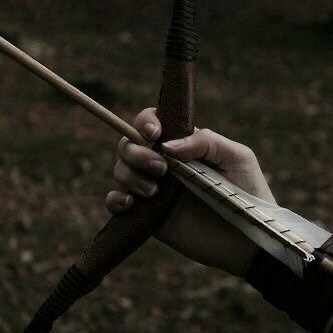
═══════ ◖◍◗ ═══════
Bibliography
http://www.deomercurio.be/en/dianae.html#abnobae
https://symbolsage.com/nature-goddesses-names/
Green, Gods of the Celts, 1986,
Dictionary of Gaulish Language
https://artsandculture.google.com/entity/arduinna
/m0lt0l?hl=en
https://www.britannica.com/topic/Diana-Roman-religion
https://www.oxfordbibliographies.com/view/document/obo-9780195389661/obo-9780195389661-0059.xml
https://www.encyclopedia.com/religion/encyclopedias-almanacs-transcripts-and-maps/greco-roman-religion-and-philosophy
The British Museum Online
#witch#witchcraft#pagan#pagan witch#roman pagan#roman religion#celtic pagan#gaulish roman paganism#gallo roman religion#gaulish polytheism#gaulish pagan#diana#diana goddess#artemis#abnoba#witchblr#paganism#pagans of tumblr
94 notes
·
View notes
Text
hi hello! my name is anne and i'm a 35 y/o woman living in the upper midwestern us. i share a home with my fiancé, our housemate, two cats, and far too many books, rocks, plants, and jars.
this is a spot for me to explore and share my spiritual practices, as well as little bits of my daily life. i've been a polytheist and occultist of various stripes since i was a kid — over 20 years — and i have a lot to say. but i still have a lot to learn, too.
all the minutiae below the cut.
⋮► traditional witchcraft, whatever that means these days. magic, alchemy, herbalism, divination, astrology, etc etc etc — all informed to a greater or lesser degree by folklore and historical record.
what i practice:
⋮► a weird mishmash of interrelated polytheisms — mostly roman, with a some heaping scoops of gaulish and brittonic mixed in. also a couple of greek and kemetic deities. help me.
⋮► bioregional animism, expressed through closeness with the natural world. i try to live with the rhythm of the seasons and to be a good steward of the land, her creatures, and her spirits.
who i honor:
⋮► the aventine triad (ceres, liber, and libera), juno, mercury, trivia, rosmerta, and sirona. the holy family, as part of my ancestral practice.
⋮► the matres, lares, penates, and my ancestors. my teachers and guides, both living and dead. the witch mother and witch father.
#polytheism#paganism#roman polytheism#cultus deorum#religio romana#gallo-roman polytheism#gaulish polytheism#gaulpol#brittonic polytheism#traditional witchcraft#tradcraft#folkloric witchcraft#historical witchcraft
12 notes
·
View notes
Link
A playlist of the presentations at the past weekend’s Gaulish convention!
Myth is Not Religion by Aliakai
Gaulish Runas System from Nemeton Dumnantu
Divine Pairings in Gaulish Polytheism by Nertatis
Frankish Polytheism/Heathenry presentation by the TFA
Abnoda Gaulish/Celtic Goddess of the Wilds by Tricunos
Ritual for Gallo-Roman Mercuralia by Viducos/Deomercurios
Stone age cosmology (neolithic origin for cernunnos??) by Beroki
Secrets of the Rhaetians (IRON AGE ALPS SUN WORSHIPPERS) by Renotauros
Travel Altars & Con wrap up with Reno again
#aliakai#runes#runas#gaulish#Gaulish Polytheist#Gaulish Polytheism#gaulish pagan#frankish#frankish heathenry#heathenry#abnoba#diana#gallo-roman#mercury#mercuarlia#cernunnos#cerunnos*#rhaetians#sun worship#altars#paganism#pagan#polytheism#convention#sirona#taranis#taranos#neopagan#neopaganism#myths
24 notes
·
View notes
Text
Green spring: Cernunnos
CERNUNNOS
Category: Gallic mythology
When people talk about the Celtic myths, they tend to focus solely on the insular Celts – the Irish legends, the Welsh tales… And they tend to forget that there was a whole other branch of Celts – the continental Celts, of which the most famous were the Gallic Celts, the inhabitants of Gaul (aka, current France). And the Gallic tribes had their own religion and mythology, which despite having a few common points with the insular Celts, also had a lot of differences, to the point it forms a very unique Celtic mythology…
But unfortunately, a Celtic mythology of which we know barely anything. For you see, the Gallic mythology was one of the least preserved of the Celtic mythologies. No Gallic literature of any form was preserved, and no Gallic tale was kept alive in medieval times (unlike the insular Celts). Due to the many differences and uniqueness between the Gallic religion and the insular Celts, trying to reconstruct the first solely based on the second is difficult and hazardous. And the main problem is that Gaul was conquered, colonized and absorbed by the Roman Empire at quite an early age and with a terrifying success, which means that a lot of the original Gallic culture was completely erased, or syncretized with the Roman one. As a result, a good part of what we know about ancient Gaul today comes from the treaties, books and observations made by the Roman themselves – and from the well-preserved “Gallo-Roman” era, where Gaul was just another province of the Roman Empire. For older times, we can only rely on archeological proofs and evidences, to try to discover and understand what the ancient Gallic mythology was about…
Which leads us to Cernunnos, THE most famous Gallic god. He is one of those Gallic deities that are completely unique to Gaul, and do not have any equivalent among the insular Celtic myths (even though some people claim Conall Cernach of Irish legends might be a cultural cousin, it is a very light theory based on very few and non-conclusive evidence), and he is a fascinating and very popular figure, to the point he is often included among the more well-known insular Celtic gods as if he was part of them. Of course, his adoption by neo-paganism (and Wicca in particular) helped boost even further this reputation. Remember the “Horned God” of the Wicca? Well originally, this was Cernunnos. Just Cernunnos. Before the neo-pagans rose up, there was only one pagan “Horned God” or “Horned One” known by this name – and it was Cernunnos (or Carnonos) whose very name contains the Gaulish word for “horn”. Heck, due to his unique nature, people even think that he is more than just a continental specificity – people theorize and claim that Cernunnos is actually a proto-Celtic god, a god from the original, primitive Celtic pantheon before it split up in all the different tribes and people we know today.
But enough history lessons – who, or what, was Cernunnos?
Well, as I said, we actually don’t know much about him. In fact we probably know less about him than any other Gallic god… It is a very strange fact that one of the most famous deities of the Gallic pantheon is the one we actually have the less about. As I said, no Gallic or Gaulish literature about him was kept, he doesn’t have any insular Celts counterpart, and even more fascinatingly he isn’t talked about by the Romans at all, who didn’t include him in their new, re-forged Gallo-Roman pantheon. When the Romans made lists of Gallic gods and syncretized them with their own, Cernunnos was absent. Or maybe he was here, but unnamed – you see, there is a strong theory that Cernunnos was actually present in those texts, but left unnamed, because in these lists formed by the Romans, there is an unnamed god mentioned and seen by the Romans as bearing at the same times attributes related to Mercury and Dis Pater. (I invite you to check my posts about them in my “Roman gods are not Greek gods” series). And from what evidence we have, Cernunnos was a psychopomp and/or chthonic deity (Dis Pater) who was also strongly associated with wealth (Mercury). So this deity might – just might – be him. But again, we are not sure.
So if nobody seems to talk or know about him… How do we even know he exists? We know this thanks to a lot of archeological evidences that clearly state he existed in the ancient Gallic religion. One such evidence is the Pillar of the Boatmen/Pilier des Nautes/Nautae Parisiaci. This monument, a column erected by Gallo-Romans on the location of current-day Paris, is one of the most importance sources when it comes to the Gallic gods since it depicts on several lines physical representations of both Roman and Gallic gods, with their names. It is unclear if the pillar actually tried to equate the Roman and Gallic deities (as in, showing them by side to say “Hey, this deity in Gaulish is this one in Latin”) or if it actually simply listed the Gallo-Roman pantheon formed by the union of the two religions, but on it, alongside Roman gods (Jove, Castor and Pollux, Volcanus, Fortuna) and other Gallic gods (Esus, Smertrios, Tarvos Trigaranos), Cernunnos appears, his name written under the depiction of a man with stag’s antlers on his head, from which hangs two torcs.
This is actually the second main “evidence” of Cernunnos’ presence: his physical depiction on various Gallic or Gallo-Roman items. His name is also written in some Gaulish inscriptions here and there, but it is rarer (beyond the pillar above, his name was also found in three other inscriptions so far). Cernunnos’ portraits were far more widespread – for example another famous depiction of him is present on the Gundestrup cauldron, a silver cauldron on which he appears as a man with antlers, sitting, holding in his right hand a torc, and in his left hand a horned serpent. To his left is a stag with antlers similar to his, and all around them are various other figures – canine and felines beasts, some sort of bovines, as well as a human riding a dolphin. There is also between the antler a sort of tree-like motif, but it is unclear if it is supposed to be a real tree growing between his antlers, or just some standard “background ornament”.
I’m not going to list you all the apparitions of Cernunnos, but overall a pretty clear imagery of the god is formed. Cernunnos appeared as a horned man, most of the time his horns being the antlers of a stag (though in very rare cases, he has ram-horns). He is usually seen with a torc, one of the most famous Gallic ornaments – sometimes he has it around his neck, sometimes in his hand, sometimes on his antlers. He is usually seated, but in a very specific position which has been pointed out as a “yoga position”, “yogi position”, “Buddhic position”, that is to say sitting cross-legged. Sometimes Cernunnos will appear as a beardless youth, other times as a bearded man; similar, while often he is depicted with only one head, sometimes he will have two face (like the Roman Janus) or with three faces (making him similar to the figure of Lugus/Lud). Cernunnos is usually depicted surrounded by animals, though one creature in particular is often present with him – the “ram-headed snake”, a very specific creature of Gallic mythology. Cernunnos often holds a bag from which spills either coins or food.
- - - - - -
With such an imagery and just a name to go by (which itself merely means “horned one” or “horned god”), we can only speculate and theorize about who Cernunnos was.
Here are the main points so far: Cernunnos seems to have been a god of nature. His half-human half-animal nature, coupled with the fact he is usually depicted by various beasts of different species, make people think that he is a manifestation of an ancient religious motif and archetype, the “Lord of the Animals” or “Lord of the Wild Things”, a figure usually seen sitting peacefully among wild animals, or holding by the horns two savage beasts on each side. On top of being a god of nature and animals, the fact he is usually seen holding a bag of coins or a bag of food (or is in the presence of a woman figure holding a basket filled with food, and more rarely he is even vomiting coins onto the world) also identifies him as some sort of god of wealth and/or abundance – which does explain why he appeared on the “Pilier des nautes”, which was a pillar tied to merchant-sailors and fluvial commerce (hence its name, “Boatmen Pillar”). In fact, it is pretty clear that Cernunnos seems to have embodied the two sides of “fertility”, on one side the natural abundance of the natural world of beasts and fruits, on the other side the material wealth one had to gain in a more urban and Romanized world.
Though his presence on the Boatmen Pillar also led some people to flat out interpret him as a god of travel and commerce, rather than just wealth itself (again, in Gaul, travel by the various rivers of France was the main way of doing commerce, and so most boat-travels were about selling or buying something). A fun fact is how people can sometimes have two completely opposite interpretations of him: for example, while some experts and future neo-pagans interpreted him as a form of aggressive, wild, dominating, genetic power of vigor and fecundity, other people rather point out that he seems to be a peaceful entity and “quiet” god, sitting cross-legged among animals and offering gifts – even going as far as to say that his half-human half-animal nature might mean he was a god of meditation, or a mediator/negotiating figure, trying to unite both sides of the world – a more peaceful idea of the “god of fruitfulness”, that brings fruits through union rather than an “aggressive vigor”.
Some people also argue that Cernunnos might have been a seasonal god of the Celts – for the antlers typically fall during winter and grow back during hotter seasons. The Celts considered there was only two seasons a year, one bright, one dark – summer and winter. And the fact Cernunnos is a nature-god of abundance, depicted with usually giant or massive antlers seem to indicate he might be an embodiment of the “bright season”/Celtic summer. Though other point out that there are similar or alternate depictions of Cernunnos, but with smaller protuberance on his head (or figures seated and dressed like him, but missing antlers), and they theorize that maybe Cernunnos, just like the real stags, also lost his antlers yearly before they regrew, and thus interpret him as a god embodying the very Gallic seasonal cycle, rather than just one season.
Oh yes, and there is one last theory about Cernunnos identity… You see, when Julius Caesar described the religion of Gaul, he mentioned that the Gaul people considered a specific god as their father and ancestor – and he called this deity by the Roman name of “Dis Pater”, a Roman god equated with Pluto, and considered to be an underworld deity of wealth. This led some people to theorize that Cernunnos might be the Gallic Dis Pater Caesar talked about – pointing out his association with wealth, and the fact that he wears some of the most iconic pieces of outfit worn by the Gaul people themselves (mainly the torc, and the breeches). As such, some wonders if Cernunnos wasn’t the “father-god” of the people of Gaul, worshiped as the common ancestor of all…
94 notes
·
View notes
Text
Notes from Ronald Hutton's lecture "Finding Lost Gods in Wales" from Gresham College
A major problem for locating Welsh paganism in historical terms is that there really is very little source material to work with, certainly not much medieval literature seems to have survived in Wales, at least when compared to other countries such as Ireland and Iceland. It was thought that several Welsh stories and poems reflected the presence of an ancient Druidic religion and thereby some form of paganism, but this idea has since been rejected. It is now believed these stories and poems originated much later, possibly dating to around 500 years after "the triumph of Christianity". Only four manuscripts written in the 13th and 14th centuries might contain some possible relevance to paganism. Hutton tells us that these are The Black Book of Carmarthen, The White Book of Rhydderch, The Red Book of Hergest, and The Book of Taleisin (so-called). About 11 stories from the White Book and Red Book were compiled into what was called The Mabinogion in the 1840s. None of these are stories are certain to be older than the 12th century, although the oldest stories in the Four Branches of the Mabinogion may have been written as far back as 1093, and according to Hutton some of the stories of the Mabinogion were actually inspired by foreign literature, including not only French troubadour stories but also Egyptian, Arabic, and Indian stories that were brought to Europe.
Hutton notes that, unlike in medieval Irish and Scandinavian literature, the stories of the Mabinogion don't seem to feature any gods or goddesses or their worshippers (at least not explicitly anyway), despite being set in pre-Christian times. Many characters have superhuman abilities, but it's apparently not clear if these are meant to be understood as gods, or magicians, or just narrative superhumans. If there are pagan survivals in these stories, it may be the presence of an otherworld realm called Annwn, often equated with the underworld, and/or the presence of shapeshifting abilities (and on this point I believe Kadmus Herschel makes a convincing point in True to the Earth about this being reflective of a non-essentialist pagan worldview). Of course, Hutton believes that these are generalized themes and no longer linked to paganism in themselves, but of course I'd say there's room for skepticism here (I'm not exactly picturing a Christian Annwn here).
An important figure within the Four Branches of the Mabinogion is Rhiannon, a woman from Annwn who often believed to be a surviving Welsh goddess or survival of the Gallo-Roman goddess Epona. Her marrying two successive human princes has been interpreted as signifying Rhiannon as a goddess of sovereignty. Hutton argues that this is not certain because Rhiannon does not confer kingdoms to her husbands, there is no clear sign of a sovereignty goddess outside of Ireland or British horse goddesses in Iron Age archaeology or Romano-British inscriptions. Hutton argues that it's more likely that Rhiannon was a member of human royalty or nobility rather than a goddess. Of course, this is perhaps a zone of contestation. Hutton does not deny the possibility that Rhiannon was a goddess, but believes that the decisive evidence is lacking. For what it's worth, Rhiannon is a unique figure in the literature of the time, as a being from the otherworld who chooses live in the human world and willing to stay there even after every misfortune or crisis she encounters, responding to every problem with an indomitable and perhaps "stoical" willpower and courage.
The mystical poems, or the court poets from 900-1300, are also thought to contain some aspect of lost Welsh paganism. These were to be understood as a kind of artistic elite that delighted in prose that was sophisticated to the point of being almost beyond comprehension. They apparently believed that bards were semi-divine figures, permeated by a concept of divine inspiration referred to as "awen". They drew on many sources, including Irish, Greek, Roman, and even Christian literature, but also apparently the earlier Welsh bards. Seven mystical poems are credited to Taliesin, and these could be dated any time between 900 and 1250, though contemporary scholars typically favour 1150-1250 as the likely timeframe. Despite probably being written at a time when Wales was likely already Christianized, the poems are repeatedly referred to as sources of paganism and ancient wisdom by modern commentators.
The poem Preiddeu Annwn is one "classic" example. It is the story of an expedition into the realm of Annwn, which is undertaken to bring back a magical cauldron. The poem that we have seems to be explicitly Christian, but it is often believed that this is merely a Christian adaptation of an older pre-Christian text. But apparently no one really knows the real meaning of the Preiddeu Annwn, not least because no one can agree on what a third of the actual words in the poem mean. No one really knows if Taliesin was demonstrating a certain knowledge that only he possessed or what, if anything, he was referencing, so in a way we just don't "get" his poem.
Over the years the court bards ostensibly developed a new cast of mythological characters, or simply an enhanced an older cast of characters, to the point that they seem superhuman or even divine, yet just as medieval as King Arthur or Robin Hood. One example of this is Ceridwen, a sorceress who first appears in the Hanes Taliesin. Court poets apparently interpreted her as the brewer of the cauldrons of inspiration, and eventually the muse of the bards and giver of power and the laws of poetry. In 1809 she was called the "Great Goddess of Britain" by a clergyman named Edward Davies, which has been taken up by many since. Then there's Gwyn ap Nudd, who appears in 11th and 12th century texts as a warrior under the command of King Arthur. In 14th century poetry he seems to have been interpreted as a spirit of darkness, enchantment, and deception, and in the 1880s professor John Rhys identified him as a Celtic deity. Another major character is Arianhrod, who first appears in the Fourth Branch of the Mabinogion as a powerful enchantress whose curses were unbreakable. Over time it was also believed that she could cast rainbows around the court, the constellation Corona Borealis was dubbed "the Court of Arianrhod", and somehow since the 20th century she was identified as an astral goddess.
Then we get to the canon known as "Arthurian legends": that is, the stories of King Arthur. Hutton says that these tales originated as stories of Welsh heroes who fought the English, and these stories also contained what are thought to be residual pagan motifs. One example is the gift of Excalibur from the Lady of the Lake, which is either based on memories of an older pre-Christian custom of throwing swords into lakes, the rediscovery of an older custom through finds, or even a persisting medieval custom of throwing a knight's weapons into a water. The Dolorous Blow which strikes the maimed king and turns his kingdom into a wasteland is thought to suggest a residual belief in the link between the health of a king and the health of a land, though the blow itself is inflicted by a Christian sacred object. The Holy Grail is often believed to derive from a pre-Christian sacred cauldron, but it was originally just a serving dish before becoming a Christian chalice.
And of course, there's Glastonbury, featuring as the Isle of Avalon, the refuge and possible burial site of Arthur. It has been thought since at least the 20th century that Glastonbury was a centre of paganism, but no remains have been found there which might suggest the presence of a pagan reigious site. And yet, in 2004, some prehistoric Neolithic post-holes were discovered near the Chalice Well garden in Glastonbury after the Chalice Well house started a kitchen extension. Although no deposits were found that suggest anything about the religious life of the area, the point stands that it was the first trace of anything Neolithic at Glastonbury. But there is perhaps always more to be found. As Hutton says, there are always new kitchen extensions, garden developments, street work, or any other renovation that might result in archaeological excavations, and we could find almost anything at any time. For my money, if there's hope anywhere, it's in that. Almost makes me want to get back into my childhood metal detecting hobby. It would certainly have a purpose: to rediscover anything from our pre-Christian past that could possibly be found.
From the Q&A we can incidentally note that many contemporary artefacts of Welsh national/cultural identity are very modern, they have nothing to do with some ancient past, but they weren't always to do with the romantic nationalism of Iolo Morganwg. The daffodil, for example, was probably first taken up as symbol of Wales in 1911, during the investiture of the then Prince of Wales. The leek, on the other hand, seems to have been symbolically associated with Wales since the Middle Ages, possibly as a reference to St David as his favorite dish, or possibly as a less then flattering reference to Welsh agriculture. The dragon, or rather Y Ddraig Goch (literally "the red dragon") as it is called here, dates back to a medieval narrative about a tyrannical king named Vortigern. He tries to build a castle but it repeatedly collapses, and according to the legend that's because two dragons, one red and the other white, are always fighting beneath the ground. The white dragon is supposed to represent the English and/or the Saxons, while the red dragon represents the Welsh and/or Celtic Britons. Although traditionally, at that time, Welsh princes took up the lion as their symbol much like English and other European royalty did, the Tudors established the red dragon as an official heraldic symbol of Wales to distinguish from English iconography, and that has been a mainstay of Welsh culture ever since. All-in-all, however, probably nothing to do with paganism here, unless the dragon has some older significance that we don't know about (and I'm inclined to be charitable here, considering that dragons in Christian symbolism usually represent Satan and/or evil).
There is the suggestion that Arianrhod is to be identified with Ariadne, the Cretan princess who became the lover and consort of the Greek god Dionysus. Both Ariadne and Arianrhod are associated with the Corona Borealis, which in Greek myth was a diadem given to Ariadne as a wedding present from Aphrodite. But that's about it. Any identification based solely on that would be a stretch.
There is the discussion of the legend of Bran, or Bran the Blessed, a king of Britain whose head was said to be buried in a part of London where the White Tower now stands. Hutton says it's possible that this may have reflected an ancient pre-Christian custom of burying parts of "special" people in "special" places to give them enduring magical/divine power, or alternatively that it references a Christian tradition of similarly venerating the relics of saints (itself possibly adapted from pre-Christian traditions in the Mediterranean, but that's another story; any input on that subject though would be much appreciated!). Hutton suggests that Bran's head being specifically buried beneath The White Tower is one of the best indications that the Four Branches of the Mabinogion as we know them were composed no earlier than the early 12th century, because the White Tower was built by William the Conqueror in 1080, and the Norman occupation in Wales as well as England at the time was part of the backdrop of the writing of the Four Branches. Hutton also suggests that stories concern parables from a distant, lost ancient time that were marshalled by Welsh poets who applied them as lessons for how to survive in the present, against the threat of Norman occupation. I should like to have answers on that front, because something about the reactivation of a distant past against the present order resonates very well with Claudio Kulesko's concept of Gothic Insurrection. It makes for interesting horizons, especially when applied to radical political dimensions relevant to things like the question of political identity in the context of the British union.
Relating to the legend of Wearyall Hill, the place in Glastonbury where Joseph of Arimathea supposedly planted the "holy thorn", there is the point made by the late historian Geoffrey Ashe (who, incidentally, died in Glastonbury) that none of the legends concerning Glastonbury have been or even can be disproved, which means that they all just might be correct. Hutton seems inclined to take what could be described as the "glass half full" side of that problematic, in that he thinks the great thing about myths and legends is that there also the possibility that there's something to them. I think that this presents possibilities for paganism, but in the sense that we are to look at it as an act of assemblage, or rather re-assemblage, and in a sense it works to the precise extent that we take it as medieval and contemporary mythology, without at the same time believing the lies that we tell ourselves through our romance and mythology.
Then there's the subject of the demonization of Gwyn ap Nudd in the Buchedd Collen, which incidentally counts as yet another Glastonbury legend. Hutton says that there is no doubt that Gwyn ap Nudd was demonized by Christians, but says that this was not specifically the work of the St. Collen myth. The legend of St. Collen was already fairly well-established in the Middle Ages, and the Welsh town of Llangollen takes its name from St. Collen. The legend goes that Collen was preaching in Glastonbury when Gwyn ap Nudd had taken over the Glastonbury Tor (Ynys Wydryn) and set up a mansion from which to tempt and seduce the inhabitants with vices and pleasures. Collen then goes to Gwyn ap Nudd's mansion and sprinkles holy water everywhere, causing it to explode and leave nothing but green mounds. Hutton suggests that by the 14th century Gwyn ap Nudd was already interpreted as a demon, but we don't really know how or why that happened. Here a horizon of assemblage emerges from the context of Christian demonization.
Gwyn ap Nudd, if taken as a Welsh or Brythonic deity, is interesting to consider as a demon invading Glastonbury and being exorcised by a Christian monk with holy water. There's an obvious question, albeit one that may have no answer: why does Gwyn appear as the subject of an exorcism myth in the context of a Christianized society? It seems plausible to consider Christians interpreted Gwyn ap Nudd as a demon by way of his already being the ruler of Annwn, an otherworld realm then recast as Hell. It may also be possible that Gwyn was a persistent reminder of an older pre-Christian polytheism, even if it's unlikely that he was actually worshipped by anyone living in the Middle Ages. Everything sort of hinges on the fact that the figure of Gwyn ap Nudd was pre-eminent enough in medieval culture, and enough of a thorn on the side of the Christian imaginary, to first of all be recast as an evil demon and then become the central antagonist of the legend of a Christian saint who exorcises him. That might allow Gwyn's presence in the legend to be interpreted as symbolic of the pre-Christian past, albeit through Christian eyes, and a figure who could represent its potential reactivation in Wales.
Lastly, there's the matter of apparent similarity between Welsh and Irish mythology, and the idea of a shared "Celtic origin" between them, in which we are again at a crossroads of possibility. That whole connection comes with a problem: there are definitely similarities between the Irish and Welsh characters at least in name, but these characters also to tend to share names more than they share almost anything else. The two explanations are either that these characters were deities that were worshipped in pre-Christian Wales as well as Ireland, or that Welsh authors were just well-acquainted with Irish folklore and literature and simply borrowed ideas from there. Hutton suggests that the first explanation may not be entirely wrong, or at least not completely invalidated, and leaves it up to the individual to decide between the two possibilities. It is very difficult to be certain is the first possibility holds up, and I have the suspicion it might not, at least not sufficiently. But it doesn't seem totally impossible, given the resonances between the mythical figures in Wales vs the pre-Christian gods of other lands. A relevant example would be Nudd, or Lludd Llaw Eraint, the mythical hero whose name was cognate with the Irish Nuada Airgetlam and apparently derived from the name of the ancient god Nodens. Not to mention Lleu Llaw Gyffes coming from the name of the Celtic god Lugus. That presents the slim possibility of connection, and perhaps assemblage by way of Irish myth.
If you want to see the full thing I'll link it below, here:
youtube
#wales#welsh paganism#britain#celtic polytheism#welsh literature#medieval literature#paganism#brythonic polytheism#glastonbury#arthurian legend#mabinogion#welsh mythology#british mythology#celtic mythology#gothic insurrection#Youtube
44 notes
·
View notes
Text
@bruxtia mentioned a statue found of a (perhaps) female version of Cernunnos. Which reminded me that I actually wrote a piece about that in 2020 but never shared here.
Cernuna?
I got a question on Twitter by a follower who wondered if I have any information about the Goddess Cernuna. I must admit, I’d read the name once in passing, while reading about Cernunnos, but I never really dove further into it, thinking that it was simply a modern pagan’s wishful thinking. After the question, however, I got curious. Is there a female counterpart to Cernunnos? Do we have evidence of a Gaulish female antlered Goddess?
Short answer: sort of.
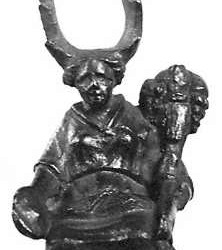
Above is a bronze statue of an antlered woman, sitting crosslegged, holding a cornucopia and a patera: a gallo-roman offering dish. The statue is currently in the British Museum, but was found at Broye in the Haute-Saône (Franche-Comté). Interesting is of course that she had antlers, and the fact that she is sitting cross-legged, something that most Cernunnos depictions have as well.

Another antlered goddess, sitting cross-legged, holding a cornucopia was discovered in Puy-de-Dôme. Her other hand is empty but was likely holding another patera. She can be seen in the Musée de Clermont-Ferrand.
The cornucopia is a symbol of abundance and prosperity. The patera is one of worship, of leaving offerings for a deity. However, often the figures holding the patera would not be the deity themself, but those who would bring offerings to them. So are we looking at statues of Goddesses, or of priestesses? Horns (or antlers) indicate a link to nature and the hunt. Which would make these potential Goddesses a Goddess of nature, the hunt, and abundance (and perhaps the harvest).

Photo by Alexander Schimmeck on Unsplash
There is also mention of a relief of a horned (not antlered) Goddess found on a piece of pottery in Richborough, Kent, but I wasn’t able to find an image of this.
Of course we know next to nothing about these figures. Their name, or what their attributes entailed. Cernuna or Cernunna would be a suitable name, meaning “horned” but whether or not She would have a link to Cernunnos is impossible to know. And if She did have a link to Cernunnos, what would it be? Is She His consort, His wife, His sister, His female form? An interesting concept to think about.
Sources:
We Are Star Stuff – Cernunnos
We Are Star Stuff – Horned Goddesses
DeoMercurio – Cernunnos
Noémie Beck – Goddesses in Celtic Religion
Ceisiwr Serith – Cernunnos: Looking a Different Way
Sharon Paice MacLeod – Celtic Cosmology and the Otherworld: Mythic Origins, Sovereignty and Liminality pg. 152-154
Miranda Green – Symbol and Image in Celtic Religious Art pg. 26-27
Miranda Green – Animals in Celtic Life and Myth pg. 237
Georgia Irby-Massie – Military Religion in Roman Britain pg. 100
50 notes
·
View notes
Text
My Lararium
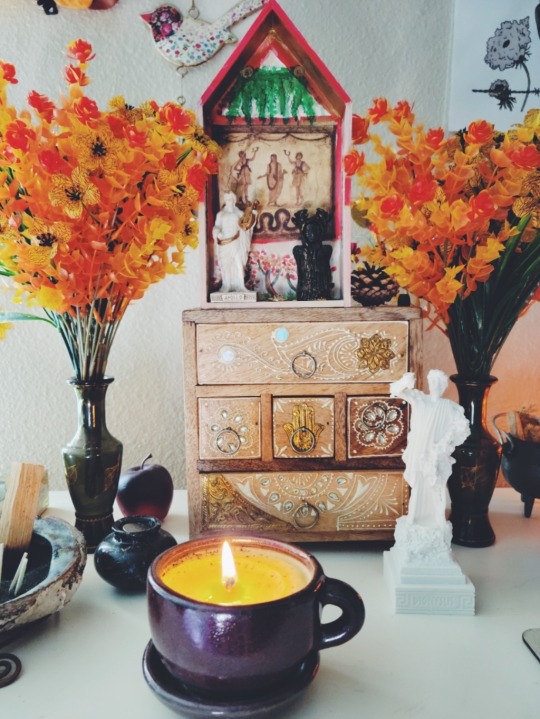
#deities#pagan#polytheism#polytheist#deity#apollo#Cernunnos#Bacchus#roman pagan#roman paganism#gallo roman#roman pantheon#gallo roman paganism#gallic gods#lararium#Altar#paganism#hellenic polythiest#hellenic polytheism#hellenic deities#hellenism#occultism#paganblr#witchblr#religio romana#cultus deorum
75 notes
·
View notes
Text



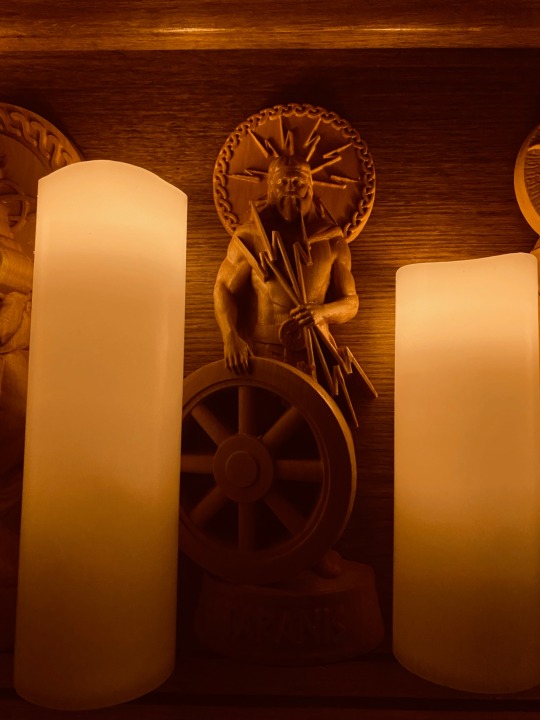



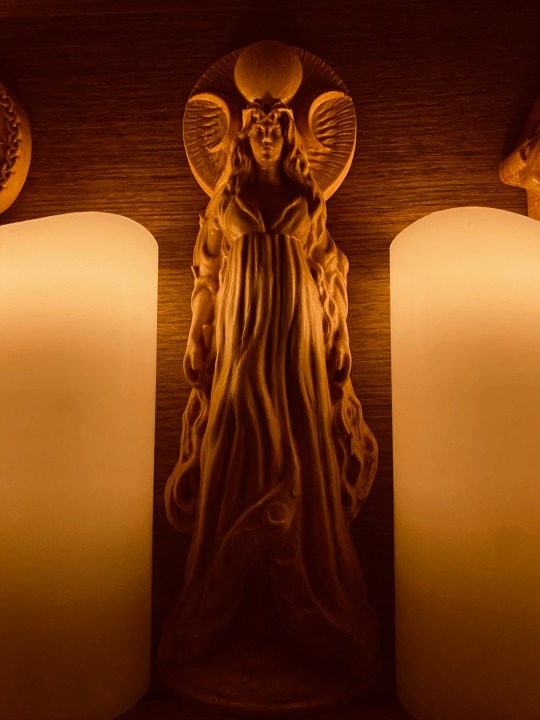
Statues by NorthMyth on Etsy
#Gods#deities#paganism#polytheism#roman#Gaul#gaulish pagan#gallo roman#statues#wooden statues#statuettes#woodcarving#cernunnos#Taranis#Epona#Janus#Sulis#sulis minerva#Moccus#the goddess#art#spirituality#celtic#altar#shrine#candles
18 notes
·
View notes
Text
~Writerly Thumbprint Challenge~
Rules: look back on your work, both past and present, finished and unfinished. what are five (or more!) narrative elements, themes, topics or tropes that continuously pop up in your work?
Thanks to @dirty-bosmer for tagging in this cool challenge, I'm still quite new to writing so I tried to look at it through the lens of my stories and the characters I write about.
I'm tagging @sheirukitriesfandom and @akaviri-dovah :) No pressure but if you do put something out I look forward to reading it :)
1. Opposition - I like to write about character relationships where the characters are very much in opposition to each other, such as different species, different sides of a conflict, etc. These relationships are often romantic but they don't have to be, and in my own original work I'm exploring this dynamic through the lens of friends and enemies. I like to write about these types of characters because I find it a great way to develop a character's values and identity when you juxtapose them with their opposite.
2. Belief in a Higher Power - Most characters I write about, and most certainly my original characters, are religious. They often have a deep sense of faith that guides them and many of them had a previous faith and end up in a different one (or following a different deity) as they grow up. Religion (especially in TES) is something I really gravitate towards and find it to be a great piece of world building. This may or may not be surprising but I was not raised religious, nor was my parent! Both of us were raised pretty agnostic and I in particular was encouraged to find my own beliefs. IRL I'm interested in Catholicism, Eastern Orthodoxy and how they were influenced by European "pagan" beliefs (Gallo-Roman Paganism represent!).
3. Abandoning the Familiar - I like to write stories about people who have left home, normally at a young age or due to unsafe circumstances. I place my characters in situations that are very different from how they were raised and flesh out their personality based on how I think they would react to entering a different environment, far from home. I also left home at a relatively young age to make my way in the world and have rarely gone back so this is mostly me, writing what I know. Though in my original work, I'm trying to challenge this and have one of the main characters live in the she was raised in.
3 notes
·
View notes
Text
A lot of my new theories and revelations have come from me actually looking outside my pagan "comfort zone"
I used to not put any faith in the Gallo Roman religion because ya know, ew, the Romans, but looking into it strengthened both my Gaulish and Germanic faiths into one, very sturdy foundation.
It's something that I wouldn't have even looked at a couple of years ago. I think we don't talk to each other enough, are afraid that it'll break our beliefs. But I think that researching and talking to different pagan faith groups and recon researchers can build upon what we know and strengthen our beliefs.
This is just a personal evolution of mine, one that I'm quite proud of since I used to be so set in my ways
2 notes
·
View notes
Text
American St. Patrick's Day is for immigrants and their descendants.
Saint Patrick's Day is a big deal in the United States because it's a touchstone for, say it with me now: resisting forced assimilation and cultural erasure by anti-Catholic and anti-Irish Americans.
In case you missed it: The banishing of the snakes (which, let's be clear, were never in Ireland to begin with) was not originally attributed to Padraig. Instead, the late 7th/early 8th century Life of Saint Columba says Columba did that one. It's not attributed to Patrick until the 12th century.
Somewhere along the line, the miracles got mixed up.
Patrick lived in the 5th century and Columba in the 6th. Formal canonization by pope didn't begin until after the 10th century. So as long as the locals were happy, the Vatican wasn't keeping track of miracles while either of them lived.
But yeah, Patrick didn't do the snakes (nobody did, but they weren't attributed to him for a few hundred years after the story was first told).
He was apparently just better at sorcery than the druids and big on doing holy well healings. His "miracles" all relate to building churches, talking to people, and being himself protected from harm.
(regardless of your belief system, you can't talk about Patrick and the druids without talking about miracles, sorcery, etc)
The forced conversion of the Irish is also a total myth. Even after the Romans pulled out of Britain and Ireland, they were still just across the water in Gaul, and association with them still meant access to more advanced technology and greater wealth. And the Romans had turned Christian.
Patrick not only didn't harm any pagans or druids, he went out of his way to not offend them.
Patrick had lived and been educated among the Gallo-Romans, but he was Welsh-born (well, Wales didn't exist. He was born a Briton) and enslaved in Ireland first before traveling to Gaul, and he would have seen and been able to speak about the quality of life in the Roman empire (Patrick is more likely to have been active in the late 4th/early-mid 5th century, and the Franks didn't finish booting the Romans out until the end of the 5th, long after Patrick had returned to the land of his enslavement).
The conversion was all carrot, no stick.
And it was slow. And Patrick neither started nor completed it. He just wasn't that big a deal.
American St. Patrick's Day is for immigrants and their descendants.
Today is the day when, annually, Irish Americans think back over their own marginalization and how they resisted it. St. Padraig doesn't mean much in Ireland, but here, the Irish Saint was a rallying point for people of a culture and faith that were looked down on as inferior. Corned beef was not an Irish food in the 19th century, but a food adopted by the Irish in America which they learned about from their Jewish neighbors.
I wonder what the refugees from the Great Famine would think about their descendants today.
My maternal grandfather was a Walsh, and the son of immigrants who came from Ireland to the US in the 1880s. He boxed with the police athletic league, worked hard to provide a good life for his wife and daughters, and helped to make his neighborhood a community. That's what I think of when I consider my Irish heritage. St. Patrick's day means little in Ireland. Here in the states, it's about immigrants surviving, thriving, and honoring themselves, no matter what their adopted nation may try to do to them.
I think it's really important that the descendants of the Irish immigrants who came here remember what their antecedents endured and avoid inflicting it on the people who came along behind them.
Immigrant solidarity here, in the US, is what matters about the day.
So yeah. I have strong feelings about Saint Patrick's Day, and about misrepresentations of it. Up the Irish! Up ALL immigrants!
---
This link goes to an entertaining article about Patrick, which in turn links to a navigable online version of the Confessio, Patrick's own writing in his own words:
1 note
·
View note